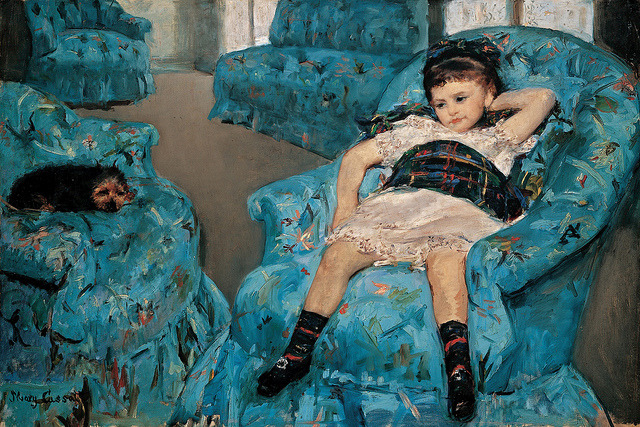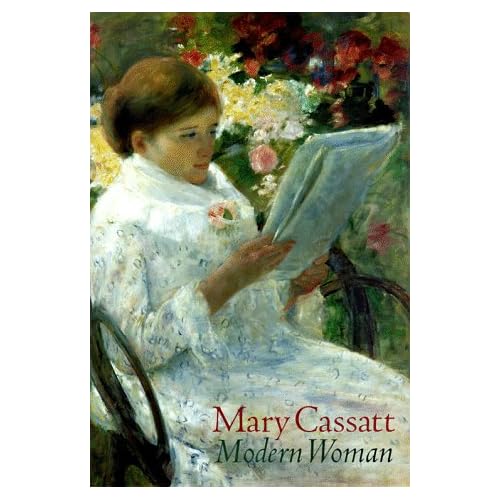The most comprehensive survey in more than twenty-five years of the work of Mary Cassatt (1844-1926), one of the leading painters of the late nineteenth century, was on view at National Gallery of Art, 6 June through 6 September 1999. Mary Cassatt brought together fifty-five of the artist's most beautiful and compelling paintings and color prints and illustrates many facets of her long and productive career. The Gallery's exhibition included important works from the Chester Dale Collection, which by the terms of Dale's bequest, cannot be shown elsewhere.
The exhibition traveled to Washington, its final venue, after showings at The Art Institute of Chicago (13 October 1998 - 10 January 1999) and the Museum of Fine Arts, Boston (14 February - 9 May 1999).
Cassatt, an adventurous modern artist and independent woman, was wholly involved in the French impressionist movement beginning in the late 1870s. A strong-willed businesswoman and influential consultant to art collectors, she was an expatriate who nonetheless always considered herself an American. Mary Cassatt traces the extraordinary career of this artist who was the only American (and one of only three women) to exhibit with the impressionists in Paris. She was recognized as one of America's most important artists in her lifetime.
The exhibition began with some of Cassatt's early subjects, derived from her travels to France, Italy, and Spain, including such paintings as

The Flirtation: A Balcony in Seville (1872)

and Offering the Panal to the Bullfighter (1872-1873). Cassatt settled permanently in Paris in 1874, and began to show her work in the impressionist exhibitions of 1879, 1880, 1881, and 1886. The exhibition includes three works from her 1879 debut with Degas, Pissarro, Monet, and others.
/Cassatt.Mary.Woman.With.A.Pearl.Necklace.In.A.Loge.jpg)
Among these is one of several of Cassatt's images depicting the theater and the opera in fin-de-siècle Paris, entitled Woman in a Loge (1878-79).

Another, Portrait of a Little Girl (Little Girl in a Blue Armchair) (1878), was innovative both in its attitude to the subject and in its composition.
By the 1880s, Cassatt was concentrating on depictions of women's daily lives --often using members of her own family as subjects--as in Tea (1879/80) and Autumn (1880).
Her tender yet unsentimental approach to the subject of mothers and children can be seen in such paintings as Mother and Child (1889) and

Breakfast in Bed (c. 1897).
These images often carried over to the artist's prints, influenced by the color effects and bold perspectives achieved by Japanese artists, as seen in The Child's Bath (The Bath) (1890-1891).
The exhibition closed with Cassatt's late paintings that relate to her monumental mural, Modern Woman, which was shown in the 1893 World's Columbian Exposition in Chicago. Although the mural was lost after the fair's closing, it served as the basis for many of Cassatt's most impressive and important works of the 1890s, including

Young Women Picking Fruit (1891/1892).
For the National Gallery's opening in 1941, Chester Dale--one of the founding benefactors--lent twenty-two American works, and a few months later, two rooms of French impressionist paintings. Among his extraordinary collection of impressionist and post-impressionist art, which he bequeathed to the Gallery in 1962, were many works by Cassatt. Visitors to the Gallery's 1999 showing of Mary Cassatt had the opportunity to view several important paintings from this collection: Study (Girl Arranging Her Hair) (1885/1886), Women in a Loge (The Loge) (1881/1882), Portrait of a Lady (Miss Mary Ellison) (1877), The Mirror (Mother and Child) (c. 1905), Revery (Woman with a Red Zinnia) (1891-1892),

and The Boating Party (1894). Ten color drypoints and aquatints from the Chester Dale Collection will also be on view in the exhibition.
The National Gallery is one of the richest repositories of Cassatt's oeuvre, with a total of 119 paintings, drawings, and prints. Four of the Gallery's nine original founding benefactors--Chester Dale, Paul Mellon, Ailsa Mellon Bruce, and Lessing J. Rosenwald--were serious collectors of the artist's work and, through their gifts, assured that all periods of Cassatt's work would be represented in the Gallery's collection.
Previous Cassatt Exhibitions
Some of the previous exhibitions that have explored aspects of Mary Cassatt's works include:
Mary Cassatt, 1941-1942, Baltimore Museum of Art--more than 150 prints, pastels, and paintings
Mary Cassatt, 1970, National Gallery of Art--an exhibition of more than 90 paintings and pastels organized to celebrate the publication of Adelyn Breeskin's catalogue raisonné of Cassatt's paintings, drawings, and pastels
Mary Cassatt at Home, 1978, Museum of Fine Arts, Boston--Cassatt's domestic world was revealed in this exhibition of paintings, pastels, and furnishings
Mary Cassatt and Philadelphia, 1985, Philadelphia Museum of Art--explored Cassatt's relationship with the art world of her home town
Mary Cassatt: The Color Prints, 1989-1990, National Gallery of Art, Washington; Museum of Fine Arts, Boston; Williams College Museum of Art--an exhibition of Cassatt's aquatints
Organization and Catalogue
The exhibition was organized by The Art Institute of Chicago in collaboration with the Museum of Fine Arts, Boston, and the National Gallery of Art, Washington. The Washington exhibition was coordinated by Nicolai Cikovsky, Jr., senior curator of American and British paintings, National Gallery of Art.

The exhibition catalogue, Mary Cassatt: Modern Woman, was edited by Judith A. Barter, with contributions by Erica E. Hirshler, George T.M. Shackelford, Kevin Sharp, Harriet K. Stratis, and Andrew J. Walker. Published by The Art Institute of Chicago, it includes four essays discussing advances in scholarship and interpretation of Cassatt's work.